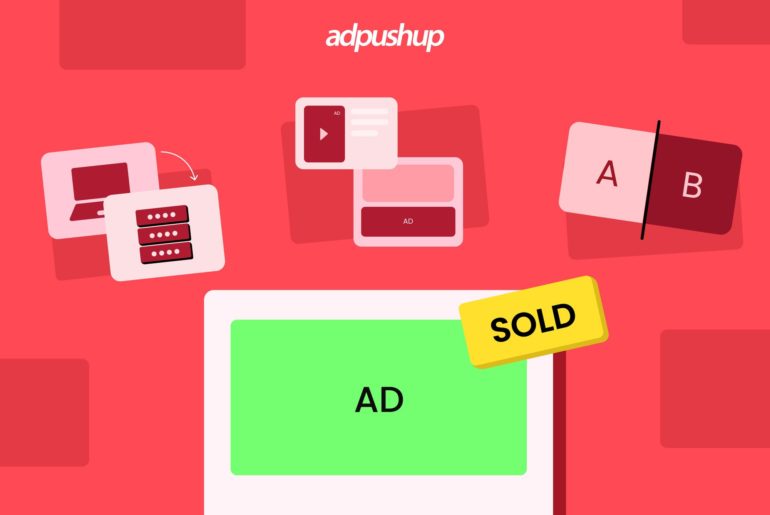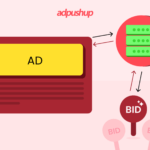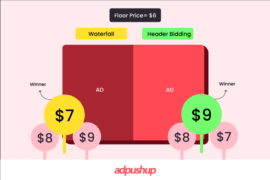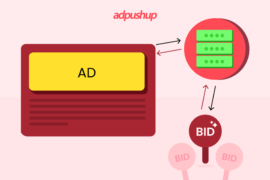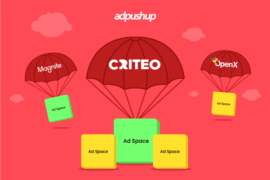Learn header bidding optimization for better ad revenue and performance with our step-by-step guide. Boost your advertising profits with ease.
Since the inception of header bidding in 2015, it has been receiving a steady adoption rate. In fact, out of one million websites with the highest traffic, 2.6% adopted header-bidding technology as of June 2022.
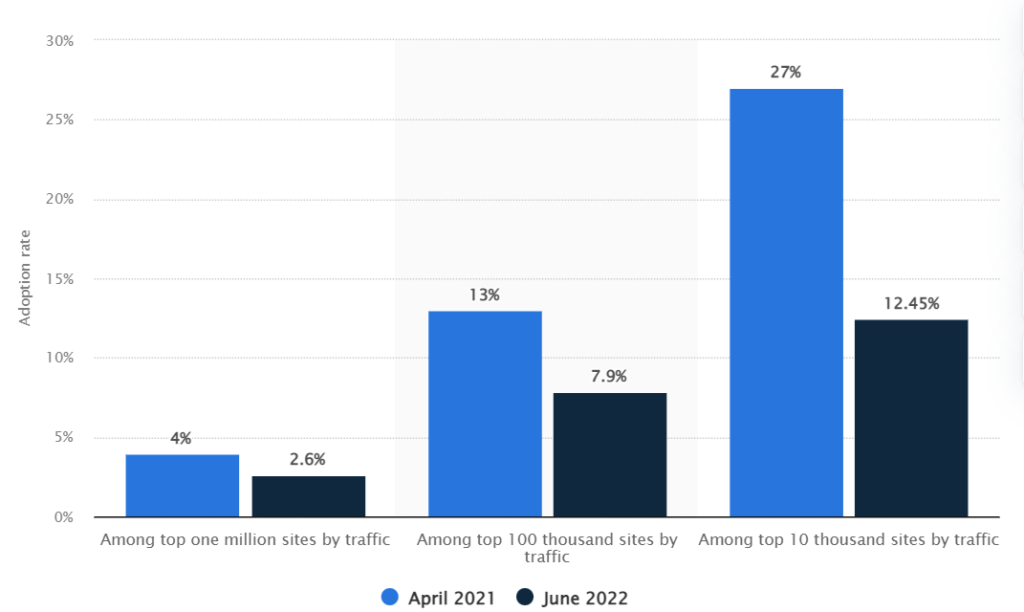
Similarly, among the top 100,000 websites with significant traffic, 8% utilized header-bidding technology, and among the top 10,000 websites, this figure rose to 12.5%.
But is it enough to just implement a header bidding setup to get better ad revenue?
The answer is a resounding no!
While header bidding offers advantages, setting it up is technically challenging. To maximize its effectiveness, ongoing monitoring and adjustments are crucial. This is where bid optimization comes in.
Bid optimization ensures that publishers are getting the highest possible value for their inventories. The end result is, of course, increased CPMs.
Without further ado, let’s get into the heart of the matter and understand why bid optimization is important its best practices, and more.
What is The Importance of Header Bidding Optimization?
Leveraging header bidding requires a proactive approach, especially when your revenue declines. By staying ahead of potential issues, you can ensure a seamless and profitable advertising experience for users. Here’s why you need to keep a close eye on header bidding.
Latency
Latency is the primary challenge associated with header bidding. Latency generally means increased page load time, slow loading of ad creative, increase in time for getting bids from the bidder, etc.
Technical Complexity
Another recurrent problem with header bidding is the technical complexity associated with it. Even though wrappers (like Prebid) have made its implementation much simpler, there are still technical complications that needs to be surpassed. Apart from these two challenges, many publishers are unable to stick to the right container technology.
However, publishers can overcome these challenges. Here’s how publishers can perform header bidding optimization for better results.
Increase in Revenue
As a publisher, your goal is to strike a balance: delivering high-quality content to your audience while maximizing your website’s revenue. With effective bid optimization strategies, you can significantly improve your chances of winning higher bids for your ad space, leading to a direct boost in your bottom line.
Better Fill Rates
Ongoing bid optimizations ensure that the publishers are not lagging behind and securing better ads for their ad inventory in terms of both quality and quantity. This will lead to better fill rates, as your header bidding set up is now running up to the current industry structure.
Better Buyers
Header bidding opens up your website to premium buyers who are ready to place bids for ad space on your website. This method of advertising is way more profitable than advertising through the waterfall method. With this, publishers have a chance to find better buyers and make more revenue.
Best Practices for Header Bidding Optimization (Bid optimization strategies)
Without proper optimization, the full benefits of header bidding can go unrealized. Here are some best practices that you can consider following for optimal results.
1. Consider Managed Services
With managed services, you have two options:
- Either implement and maintain Prebid themselves (i.e. through in-house developers)
or - Opt for a managed header bidding service.
Publishers who have previously implemented complex and custom header bidding in-house can stick to the former. They might be at an advantage in maintaining header bidding personally since they are aware of customizations suited to their needs.
But in-house management takes time and consumes resources.
If time and resources are not abundantly available, then we recommend such publishers to use managed header bidding services. Such services further offer features that make both the initial implementation and maintenance of header bidding easy.
Also Read: In-House vs Managed Ad Tech Services
“You shouldn’t look at an existing solution and ask “how can I retrofit that technology to solve my business challenges? Instead, you should look at your business challenges and ask “how can I work with a technology provider to develop the best possible solution to achieve my goals.“
Kevin Haley, Chief Scientist, Videology
One of the best advantages of working with managed services as a part of your header biding optimization is upgrading to new Prebid versions. It’s because upgradation is a tiresome job involving technical complications, and publishers can end up delaying it.
This can negatively impact monetization since they are missing out on the latest optimizations and features of Prebid.
2. Transition to Server-Side Bidding
Publishers, these days, have options to choose from client and server-side header bidding. The server-side option has recently been presented as a solution to latency issues caused by client-side setup.
Page latency can occur from having to call multiple demand partners directly from the browser. S2S bidding, however, makes one call that pings all the bidders on the server-side. This ensures that ad load time is reduced for providing users with an enhanced experience and facilitating higher viewability scores.
Switching to server-side bidding though is a concern for publishers, as cookie match rates are comparatively lower with this bidding type. This can affect revenue generation.
However, the ad tech industry is quickly heading towards a post-cookie era. Google Chrome has already promised the sunsetting of third-party cookies since 2022. Hence, this issue will not hold meaning within a few years.
Prebid, the most popular HB wrapper, has a server-side solution called Prebid Server with additional benefits such as better transparency, reduced page latency, unified auctions, support multiple demand partners, etc.
Also Read – What are Header Bidding Wrappers? How Do They Work?
3. Implement Innovative Ad Formats
Implenting innovative ad formats as a part of your header bid optimization can work work wonders. Traditionally, publishers have used header bidding for banner ads. However, website users have learnt to subconsciously ignore such ads. This phenomenon is commonly called banner blindness.
However, several innovative ad formats have entered the ad tech industry, and render publishers with much better revenue. Some of these include outstream video ads, native ads, sticky ads, etc.
These ad formats can help retain user attention, offering much higher CPMs as opposed to traditional formats. This can boost header bidding performance by offering better inventory potential to the demand partners.
Several publishers partner with an ad network that provides header bidding (like AdPushup). We encourage such publishers to assess whether their desired ad tech partner offers multiple innovative ad formats or not.
Check out some innovative high-impact ad formats that AdPushup offers: Innovative Ad Formats
To include innovative ad units, publishers need to implement certain changes in their header bidding wrapper.
Ad units need to be called out in the header by entering ad unit sizes and identifier codes in the header. The place for entering these parameters depends on the wrapper that a publisher is using.
For example, if a publisher is using Prebid as their header bidding wrapper, the edits will have to be made in the variable “adUnits”. The publisher will also need to put in unique parameters for bidders who will be serving ads on these ad units.
4. Optimize Ad Layouts
You’re probably missing out on a lot if you’re still not experimenting with the ad layouts as part of header bid optimization efforts.
If a publisher is just using standard ad layouts, they are most likely missing out on ad viewability optimization. This directly implies lesser revenue generation.
An ideal way to deal with this is to make sure that ad layouts are personalized for users.
Here’s how publishers can optimize their ad layouts to increase header bidding performance:
1. A/B Testing
We cannot stress enough on how important it is to test your page layout for assessing which ad units produce the best CTR. We encourage publishers to test for page load time, ad formats, ad positioning, and other important factors for improving the ad layout of a web page.
2. Top ad unit
If your top-performing ad unit in terms of CTR is not loading faster than others or can be boosted by trying out a newer ad format, you are clearly missing out. This also relates to ad testing wherein you consistently figure out how to boost your top ad unit performance.
3. Location
Ad location on a web page is pivotal to improving ad revenue. Imagine if a reader is browsing through your web page but ads at the wrong places are ruining their experience?
This is why it’s important to test where exactly you should render your ads on a page. As a rule, publishers need to find the balance between aiming for enhanced user experience and earning maximum CTR out of your ad units.
Also Read: Increase your Income Using Ad Layout Testing and Optimization
By taking care of such issues, publishers are essentially inviting a larger number of demand partners, and in turn, avoiding revenue loss.
5. Use Prebid as a Header Bidding Wrapper
Many publishers today are utilizing Prebid as their header bidding wrapper for their header bid optimization efforts, due to its highly flexible nature. Prebid allows customization to meet specific needs.
Further, it allows publishers to set up a timeout for bidders. If one of the demand partners is not responding to bid requests in an optimal amount of time, the whole process can be stalled. Furthermore, publishers are free to add their own yield partners via their adapters to various auctions.
Choosing the ideal header bidding wrapper is important for publishers, as it basically sets the rules for auctions. Prebid allows for seamless implementation of header bidding and takes care of latency issues, which is a major issue for client-side bidding.
6. Limit the Number of Bidders
When you’re about to optimize your header bidding setup and want to do it the right way, you need to limit the number of bidders to keep the page speed in check. Too many bidders on your page can cause latency issues. As a publisher, you should always keep the number of bidders limited and not go overboard with it.
7. Limit the Number of Bidders
When you’re about to optimize your header bidding setup and want to do it the right way, you need to limit the number of bidders to keep the page speed in check. Too many bidders on your page can cause latency issues. As a publisher, you should always keep the number of bidders limited and not go overboard with it.
8. Set Timeouts
Ensure that you have set timeouts in the bidding process. You can set a timeout duration to select the response time for ad requests. This will make the ads load faster on your page as bidders will be taking less time due to the timeout.
9. Use Ad-quality Tools
Using ad quality tools, you can create filters to block out low-quality ads and ensure quality content on your website. Low quality ads can dampen the user experience on your website and also lead to page latency.
Being a publisher, you should know about the tools you need to use and how to ensure quality content on your websites.
10. Focus on User Experience
Apart from ad formats and online tools, one of the most important things you should focus on is the user experience. When optimizing your headers and footers, you should always keep your audience in mind. Before taking any decision, see how it would affect visitors of your website. Ensure that ads aren’t disrupting the flow of content on your web pages.
Additionally, you need to make sure that your header setup complies with privacy laws and regulations. To do this, you should check out the GDPR and CCPA guidelines.
11. Optimize for Both Mobile and Desktop
Next, you should optimize headers for both mobile and desktop devices. You should know how many of your visitors use their mobiles to visit your website and how many use desktops. With this, you’ll know what you should focus on.
Most publishers underestimate the potential of header optimization for mobile use and this limits the success they achieve.
12. Monitor Performance
When it comes to header bid optimization, the job of a publisher never ends. Just setting up basic configurations won’t maximize your success, you should constantly keep checking the results and monitor your performance.
What Not to Do With Header Bidding Optimization
Header bidding optimization is a complex process, along with things you need to do, there are also things you should avoid. Now let’s discuss what you shouldn’t do when optimizing your bids.
- Have too many bidders on your site
- Set high timeout
- Have latency issues
- Not following data regulations
- Avoid testing and monitoring results
- Have low-quality ads on your site
- Ignore recorded data
- Not optimizing for mobile users
- Ignore UI design for ads
- Keep using the default setting headers
When it comes to bid optimization, having these problems prevents your site from reaching its potential and limits revenue. Ignoring these crucial factors can negatively affect your site. For publishers, it is important to keep working towards improving their site so they can earn more.
Now that you know what not to do with bid optimization, let’s move on and discuss AdPushup’s header bidding optimization solution.
AdPushup’s Header Bidding Optimization Solution
Merely deploying header bidding in your ad stack isn’t enough. Consistently optimizing it with technical improvements is the need of the hour. This is what AdPushup’s header bidding solution does. Through our multiple optimization features using data science and machine learning, we help publishers maximize their yield.
With our header bidding solution, you get:
Automatic demand partner selection according to optimum requirements
Smart timeout management
Freedom to bring your own demand
Bid monitoring and discrepancy resolution
So, schedule a demo today and see it in action!
Final Words
It is safe to say that more publishers will be shifting to header bidding in the future for improving their ad revenue. Merely adopting header bidding isn’t enough, it’s important to improve the ad performance by actively keeping up with the header bidding optimization methods.
Publishers need to pay attention to ad layout optimization and innovative ad formats for increasing ad viewability on their pages. Increased ad viewability will encourage more demand partners to bid on their ad inventories.
Additionally, a proper header bidding wrapper gives publishers the freedom to conduct their auctions in a customized way. With a wrapper like Prebid, publishers are allowed to implement advanced criteria for conducting auctions.
Frequently Asked Questions: Bid Optimization
In header bidding, bid optimization is a process that refers to increasing the revenue and filling the ad space by optimizing the bid parameters and algorithms that are set forth by the demand partners.
Bid optimization helps publishers maximize their revenue because it allows them to get the highest possible value for their ad inventory. By optimizing the bid parameters and algorithms of demand partners, publishers can attract the highest bidding demand source to display ads.
Furthermore, bid optimization can help improve fill rates by identifying and addressing any issues with demand sources that are not bidding or underbidding.
There are multiple methods publishers can use for effective bid optimization. These include header bidding wrapper solutions, auction time bidding, Server-to-Server (S2S) Integration, and more.
Not to mention, publishers should be well-versed in the parameters and algorithms of demand partners. All of these practices can be quite complicated, therefore, enlisting support professionals can be considered a feasible solution.
When choosing a partner for bid optimization, you should take a look at their performance to ensure that they can provide long-term services to your site. After the performance evaluation, check their expertise and prices to see if their business is a match with yours.
Adsense provides revenue based on the number of clicks while header bidding provides revenue based on the number of impressions. This means depending on how your site performs, header bidding can be better than AdSense and vice versa.
Header bidding has been known to outperform AdSense in most cases.
An ideal load time should be between 1 and 2 seconds.

Deepak has a keen eye for detail and a deep understanding of the ad tech landscape. Whether it’s through in-depth articles, thought-provoking insights, or compelling storytelling, he’s dedicated to helping people navigate the complex world of ad tech with the simplicity of his words.
